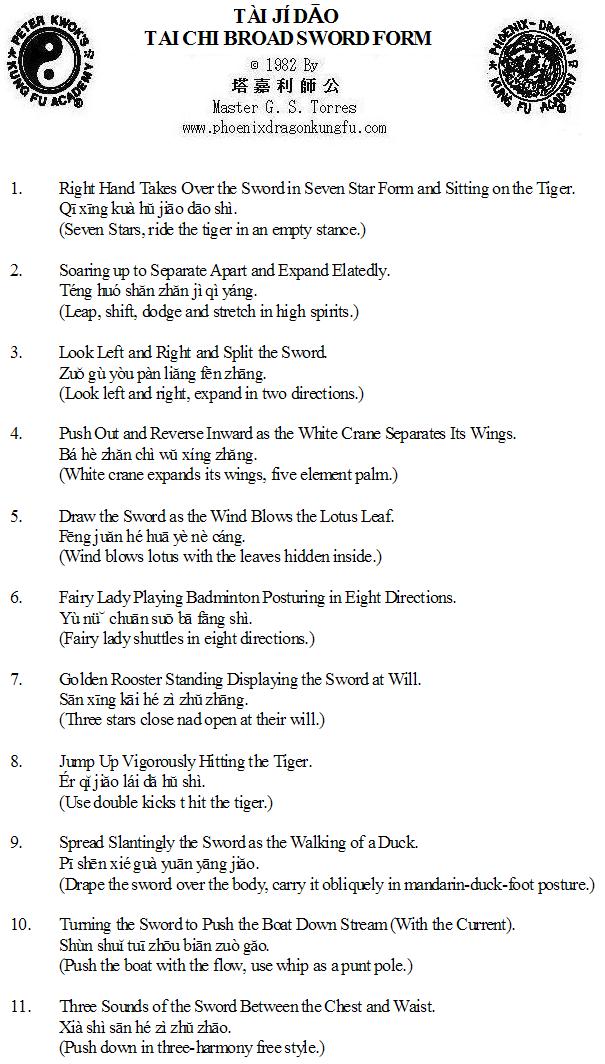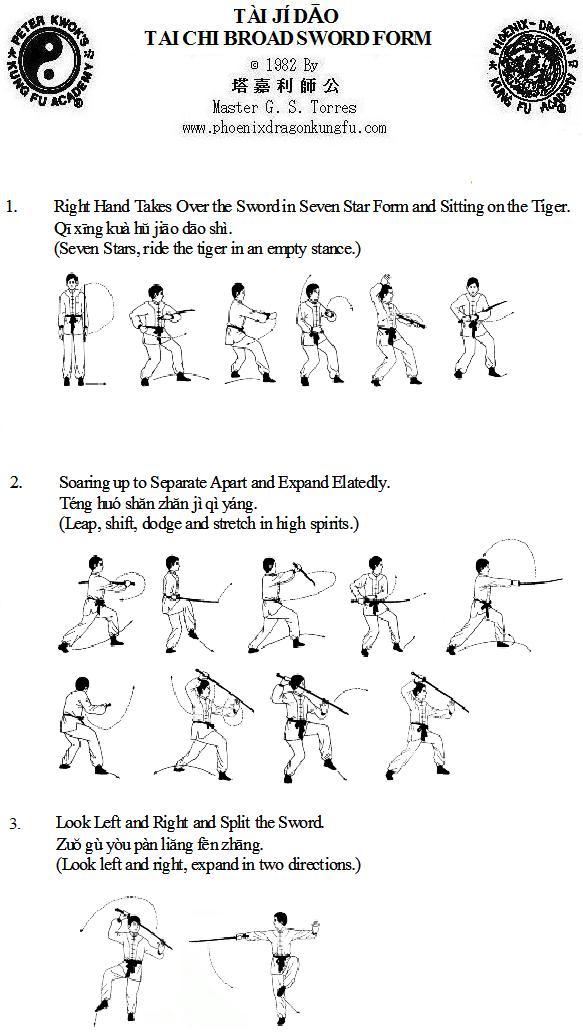Tai Chi Broad Sword Form
The following are pages was taken from the booklet on Tai Ji Dao (Tai Chi Broad Sword Form).
The Tai ji family contains the fist, sword, saber/broad sword, spear, simple push hands and big pull/stroke. Although all these exercises have distinguished styles, they all share one common characteristic, which is “bearing firmness in gentleness, needles hidden in cotton, and movements are continuous and nonstop.”
The form described in this chapter, is fairly different from the traditional “Tai ji Thirteen Saber Play.” Tai ji Saber is based on the attacking moves of traditional short saber play, such as split, shop, intercept, stick up, swing up, push, thrust, hold up, cut, wipe, hack, hang, carry, block and sweep, and combines with Wu shu’s unique steps, footwork and body movement to form a short weapon exercise. It has attacking elements, but also has Tai ji’s characteristics; gentle, flexible and continuous.
Practicing the Tai Chi Broadsword or Saber, is the same as practicing fist or open hand forms. Therefore, it is also beneficial to one’s nervous system, cardiovascular system, respiratory system, digestive system and metabolism in general. In the meantime, “dance with saber” is more interesting to practice than being empty handed.
Tai Ji Dao Exercise Method
- When practicing the Tai ji saber, the head should not be slanted or facing upward. Chin must be withdrawn, head held upright, as if it is carrying something on top of the head, the so called “push against suspension” technique. However one must avoid looking stiff simply because the head is held upright and the chin is withdrawn. Pay attention to loosening the neck muscles when holding the head upright, the so called “empty collar top strength” technique. One must look straight forward and should not look sideways during practice. The mouth naturally opens and closes. The tongue leans against the roof of the mouth. Breath out through the mouth and breath in through the nose naturally.
- When practicing the Tai ji saber, one’s body must be straight, spine and tail bone must be straigh and not inclined. But, this does not mean that the body is stiff and without any flexibility. During the practice, when the changes in movement are encountered, the body must be able to change by bringing in the chest, straightening the back, sinking the shoulders and turning the waist. It is said, when encountered with opening and closing changes, the body should have the flexibility of bringing in the chest, straightening of the back, sinking of the shoulders and the turning of the waist. Beginners must pay attention to these, otherwise, it will be difficult to correct later, and the body will become stiff. You may exercise a lot, but it will be hard to take full advantage of what the exercise has to offer.
- When practicing Tai ji saber, joints and muscles on both arms should relax. The shoulders should sink. The elbows kept hanging down and always bent to form an arc, palms are slightly open, fingers are straight and slightly bent.
- When practicing Tai ji saber, the two legs must be able to distinguish emptiness from solidness. When the weight falls on the left leg, the left leg is solid, while the right leg is empty and just touching the floor, and vise versa. The so called emptiness does not mean “hollow.” The strength still exists, and it has the potential to stretch, withdraw and make changes. The so called solidness does not mean over using force, it simply means “substantial.” Therefore, when bending knees to squat, you only need to squat slightly. If you do a half squat, it is overusing force. In the meantime, half squatting causes the body to lean forward, losing its straight up position, and therefore violating the “no leaning” rule.
- When practicing Tai ji saber, stepping forward and backward must be performed like a cat walking. Raise the foot quickly and drop the foot lightly. When kicking, keep the bottom of your foot flat, toes pointing forward. But, do not over tighten the foot. Tendons and muscles on the legs and foot should be relaxed. Kicks should be released slowly.
- When practicing Tai ji saber, silence must be maintained. Your mind must be focused, and attention be paid to every detail of the moves. Do not think about other things when practicing, otherwise, the practice becomes casual, decreasing the value of this exercise.
- When practicing Tai ji saber, natural breathing is a must. Do not allow the movements to affect your natural breathing. Although like Tai ji fist, Tai ji saber strives for deep breathing that reaches the “Dan Tian Point.” Beginners do not have to obey this rule, normal diaphragmatic breathing is suitable. You do not need to practice rising and sinking of the diaphragm. Otherwise, if breathing becomes unnatural then moves become unnatural, making breathing and movement difficult to coordinate with each other.
- When practicing Tai ji saber, one must use round and flexible strength not stiff strength and clumsy force. “Round and flexible strength” means when your body and four limbs move naturally or in a standing position, relax those tendons, muscles and joint that may be relaxed to the maximum extent. But, the maximum relaxation is not equal to slack, meaning to use minimum force to push movement, in other words, to support the bones with the lowest level of tension of muscles.
- When practicing Tai ji saber, movements must be complete and continuous. The body and four limbs’ movements follow each other and coordinate with each other. Especially the coordination between the saber, hand method, and foot work, it should be harmonious and consistent, the so called “once one body part moves, there are no parts that don’t move.” It must be avoided that hands are moving but the feet are not or the saber is moving but the hand is not. In the mean time, one move must follow the previous one, making the entire set of saber play a single movement from the opening to the closing posture. No stops are in between moves. Although sometimes a short pause is necessary, it is simply to slightly slow down, not to completely stop.
- When practicing Tai ji saber, one needs to be slow not fast. But “slow” does not mean “obtuse” or “overly gentle.” Theses two problems need to be avoided. In the mean time, speed should be maintained the same from the beginning to the end. Do not be fast at one time and slow at another.

